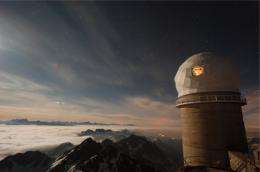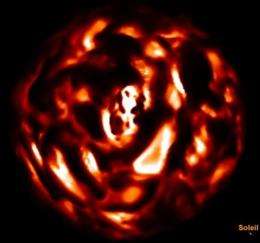Betelgeuse, a boiling and magnetic supergiant star

(PhysOrg.com) -- An international research team, lead by French astrophysicists from the Laboratoire d'Astrophysique de Toulouse-Tarbes, has detected a magnetic field at the surface of the supergiant star Betelgeuse. This observational result, published in the journal Astronomy & Astrophysics, demonstrates that, in spite of the theoretical framework usually proposed to account for the magnetism of astrophysical bodies like the Earth or the Sun, the rotation of cosmic objects is not a necessary ingredient to trigger the efficient generation of a magnetic field.
According to a scenario elaborated more than half a century ago, the rotation of stars like the Sun produces huge flows of ionized material in their internal layers. These large-scale flows trigger a dynamo mechanism causing the continuous generation of their magnetic field. This process, called a "large-scale dynamo", is generally invoked to describe the solar magnetic cycle, which is particularly spectacular during solar eruptive phases. Yet, even when the Sun is having a temporary respite in its magnetic firework, for instance during the last, unusually long activity minimum that recently ended, our star still hosts a surface magnetic field. The origin of this residual magnetism, which seems to be unaffected by the solar cycle, is still a disputed question among astronomers.
The key of this enigma may be hidden in supergiant stars, a class of objects of which Betelgeuse is one of the most famous members. With about 15 times the solar mass, 1,000 solar radii and a luminosity 100,000 times higher than the Sun's, Betelgeuse is a star reaching the end of its life while burning the last remaining nuclear fuel at its disposal before exploding as a supernova. In addition, another physical parameter of Betelgeuse is differing from the solar case : its rotation is extremely slow. It takes probably several years for Betelgeuse to complete a full rotation, against barely one month for the Sun. This situation seems inadequate to allow for the onset of a large-scale dynamo.

However, observations collected with the NARVAL instrument at Telescope Bernard Lyot (Pic du Midi Observatory, France) reveal a weak polarization level in the light emitted by Betelgeuse : an observational clue unveiling the presence of a weak magnetic field at the surface of the star. This observation is therefore demonstrating that a fast rotation is not a necessary ingredient for the efficient production of a magnetic field. Supergiant stars may use another trick : vigorous convective motions, similar to a continuous boiling, are evacuating the huge amount of energy released in the stellar core by nuclear reactions. Observations obtained at Pic du Midi suggest that this continuous agitation is able, in itself, to generate the stellar magnetic field, through "small-scale" dynamo processes operating on the same scale as the convective cells. Since the Sun itself is exhibiting turbulent motions in its outer layers, it could very well be able to host a similar type of small-scale dynamo, that could be (at least partly) responsible for its residual magnetism during activity minima.
Furthermore, the detection of a magnetic field on Betelgeuse is precious for several reasons. Massive stars reaching the end of their evolution, like Betelgeuse, contribute to spread heavy chemical species in the Galaxy, thanks to a strong wind constituted of ionized particles. Current theoretical models have trouble explaining why the wind ejection is so efficient in supergiants. Here again, the solution is maybe linked to the presence of the magnetic field, due to its known ability to accelerate charged particles.
Boiling and magnetic, supergiant stars therefore seem to constitute perfect cosmic laboratories to test the recent theories developed to explain the generation of magnetic fields in the Universe.
More information: "The magnetic field of Betelgeuse: a local dynamo from giant convection cells?", by M. Auriere et al. Published in Astronomy & Astrophysics, 2010, vol. 516, L2 www.aanda.org/10.1051/0004-6361/201014925
Provided by Astronomy & Astrophysics


















